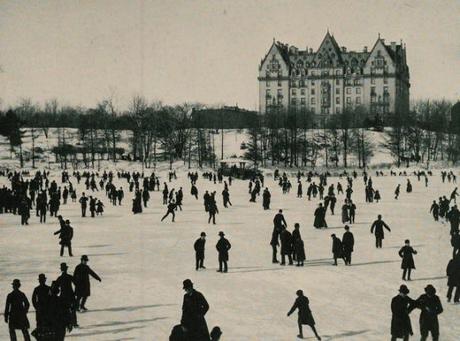In 1983 Mark Helprin published Winter’s Tale, an epic on the scale of Moby Dick and similarly steeped in symbolism. It is one of my favorite books. It clocks in at around 800 pages and it’s not light reading. Helprin masterfully weaves in themes of physics, mythology, human and divine love, religion and philosophy, but ultimately Winter’s Tale is a paean to New York. And especially New York in winter.
If you haven’t read the book, read it in the wintertime, on snowy days when the windows are frosted or on clear, blustery days when the blue of the sky is reflected in ice. Some of Helprin’s prose is really poetry, which is probably one of the reasons I like it so much. It can be over-florid, too, in the way that the palace at Versailles can be overwhelming: SO MUCH ORNAMENTATION! EVERYWHERE! You may need to leave the book from time to time to catch your breath, but you will come back. Helprin somehow captured the voice of winter in his book, in the words and sounds and people and places. I’m in awe of him, and of any writer with such an instrument.

There are some mild spoilers that follow. Probably nothing that would diminish your enjoyment of the book, but be warned nonetheless.
I think of this book today not only because of last week’s storm that brought snow to the already suffering Northeast, but also because of Helprin’s interesting concept of “the just city,” a notion that pervades the story and leads the characters from across time and space to the book’s climactic final moments. There is a confrontation between good and evil, but not in the sense that we ordinarily expect. There is a character, Peter Lake, who is a burglar but has a pure heart, and another character, Pearly Soames, who is evil but with a highly refined aesthetic sense. A beautiful girl dies, seemingly without meaning or consequence. A newspaper works to maintain journalistic integrity while its competitor churns out garbage. (Worth noting here: although Winter’s Tale appeared more than twenty years ago, Helprin’s sense for the future was uncanny. In one scene he mockingly describes a workplace that sounds a lot like Google. In others, he foreshadows the rise of reality television culture.) These characters are brought together as a mysterious architect – who may or may not be Lucifer, the book is ambiguous – foments chaos in the city so that he can build a “bridge” to “the place that had cast him out” centuries before.
The Armageddon-like event, it turns out, is the harbinger of the just city itself, because Helprin’s idea of justice is not the Augustinian complete good or the absence of evil, but rather the perfect balance of the two. Many Eastern religions are dualist in this way, positing that both good and evil are necessary parts of a journey towards, not the eradication of suffering, but the perfect integration of the many parts into the whole. The destruction of the city, and of a magical wintry place Helprin calls The Lake of the Coheeries, seems to be necessary in order to bring the earthly plane into balance with the world the architect longs to return to.
The bridge fails, though, because perfect balance is not achieved. The city begins to rebuild. Helprin paints it a bright future, although he’s careful to note that baddies remain among the heroes. Neither, he seems to suggest, can exist without the other.
A great city is nothing more than a portrait of itself, and yet when all is said and done, its arsenals of scenes and images are part of a deeply moving plan. As a book in which to read this plan, New York is unsurpassed. For the whole world has poured its heart into the city by the Palisades, and made it far better than it ever had any right to be.
But the city is now obscured, as it often is, by the whitened mass in which it rests – rushing by us at unfathomable speed, crackling like wind in the mist, cold to the touch, glistening and unfolding, tumbling over itself like the steam of an engine or cotton spilling from a bale. Though the blinding white web of ceaseless sounds flows past mercilessly, the curtain is breaking . . . it reveals amid the clouds a lake of air as smooth and clear as a mirror, the deep round eye of a white hurricane.
At the bottom of this lake lies the city. From our great height it seems small and distant, but the activity within is apparent, for even when the city appears to be no bigger than a beetle, it is alive. We are falling now, and our swift unobserved descent will bring us to life that is blooming in the quiet of another time. As we float down in utter silence, into a frame again unfreezing we are confronted by a tableau of winter colors. These are very strong, and they call us in.
Mark Helprin, Winter’s Tale (Houghton Mifflin Harcourt Pub. 1983)
